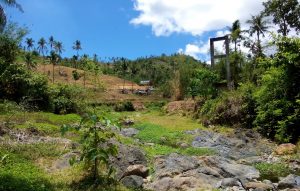By Cindy Joy D. Blasurca, CDO III – Aklan

Barangay Blasco is an upland barangay of hospitable and generous people whose houses dot the corn-strewn hills and mountains. It is a mere nine kilometers away from Poblacion, Pilar, Capiz. Yet its proximity to the town proper is a fragile reality that rests on the mood of the temperamental Sibala River traversing the area.
It is a mere 15-minute motorcycle ride from the Poblacion towards the barangay. But after a light rain, the usually mundane trip turns into an adventure because of the bumps on the rugged road, the lifting of legs when approaching water-filled potholes and a shriek when dirty water splashes on the face if the driver could not avoid muddy ponds. On top of these, the motorcycle has to take a dip in the river twice.
Blasco was not spared when Typhoon Yolanda hit in 2013. The super typhoon destroyed houses, damaged sources of livelihood and further limited access to and from the barangay because the Sibala River became deep and dangerous.
In 2014, Kalahi-CIDSS National Community-Driven Development Program went to the municipality of Pilar. Utilizing Disaster Response Operations Procedures, it allocated funds for the affected communities to repair damages caused by Yolanda or help them to become disaster-ready and resilient. Kalahi-CIDSS NCDDP is a core social protection program of the government implemented by the Department of Social Welfare and Development alongside the Pantawid Pamilyang Pilipino Program (4Ps) and Sustainable Livelihood Program, all targeting interventions for a specific segment of the poor – households, group and the whole community.
During the consultation meeting at the municipal level, community volunteers from Blasco presented to the forum their desire for a hanging footbridge which they have been desperately lobbying with the local government unit for years. They needed the footbridge for easier crossing to the nearest barangay but, most especially, for safety during heavy rains when the river rises.
Though the request was approved, the grant allocation amounted to only P482,000.00. It fell way short of the P611,000.00 estimate needed to complete the proposed sub-project.
But the proponents were undaunted even if other members of the forum urged the volunteers to change their proposal.
“Mangita kami sang pamaagi nga madugangan namon ina nga pondo para mahuman gid ang amon proyekto (We will look for ways to add to the existing funds to finish our project),” said Mario Bawisan, Sr., the development-oriented Punong Barangay.
“Maski mabayanihan pa kami para lang matapos ang footbridge (Even if we have to work for free just to finish our footbridge),” added by Marietta Bawisan – Barangay Sub-Project Management Committee chairperson and sister-in-law of the Punong Barangay.
Fortunately the beauty of convergence worked in their favor.
Looking for additional funds, the Area Coordinating Team helped the barangay explorepossible sources and presented this concern to the meeting of the Municipal Action Team. The staff of the Sustainable Livelihood Program said they could possibly complement the sub-project through cash for work and requested relevant documents from the ACT to be attached to the community proposal. The Pantawid Pamilya staff also committed to inform the 4Ps beneficiaries of the planned intervention.
Sadly, the cash for work program was good for only 15 days paid labor. When it ran out, the residents started to take turns in rendering free labor to finish the sub-project. Even the members of the Barangay Council joined in the bayanihan activity. Rainy days and the need to provide for their own daily sustenance threatened to delay the completion of the sub-project. But the barangay residents never gave up.
After 112 days, the 14.4 – linear meter hanging footbridge was completed through complementation of funds from Kalahi-CIDSS and Sustainable Livelihood Program and 97 days of bayanihan. The community disbursed only 395,215.87 from the first tranche request of funds amounting to P433,800. SLP contributed P134,325.00 which employed the Pantawid Pamilya beneficiaries. The seemingly insufficient funds made possible the P611,000.00 –footbridge without having to request the second tranche of grant allocation.
It was another great blessing that the Department of Interior Local Government through its Rehabilitation After Yolanda Program already pipelined the construction of a 30-linear meter hanging foot bridge costing P2,006,150.00 in 2016 for the first and wider crossing, following the Kalahi-CIDSS sub-project design.

“Daku gid amon pasalamat sa gobyerno sa sini nga bulig paagi sa Kalahi kag SLP (We are very grateful to the government for this help through Kalahi and SLP),” proudly declared by Punong Barangay Bawisan during the blessing of the completed hanging footbridge last May 19, 2016.
Barely four months later, however, in the evening of September 18, the hanging footbridge was torn from its towers by drifting logs carried away by a flash flood. Two days after, the Kalahi-CIDSS NCDDP technical persons visited the site and validated the incident. They determined that the sub-project can still be repaired, yet again, the remaining funds will not be sufficient for the planned rehabilitation.
It was a blessing-in-disguise that the book of accounts for the sub-project had not been closed due to a delay in the turn over. Had the sub-project been turned over last May, the community could no longer utilize the procurement savings and avail of a second tranche fund. Thus, on September 25, the community held a special barangay assembly to discuss the status of sub-project, agreed on the repair and strategize for resource mobilization.
Initially, the community has around P87,000.00 from procurement savings, unutilized first tranche and second tranche funds to be requested including the contingency amount. The local government units – both municipal and barangay together with the Sustainable Livelihood Program committed to contribute cash counterpart. Amount will be determined after the finalization of the supplemental Program of Works.
Hopefully the funds are enough. But for sure, the bayanihan spirit will still be there when called upon. (Kalahi-CIDSS/DSWD)
